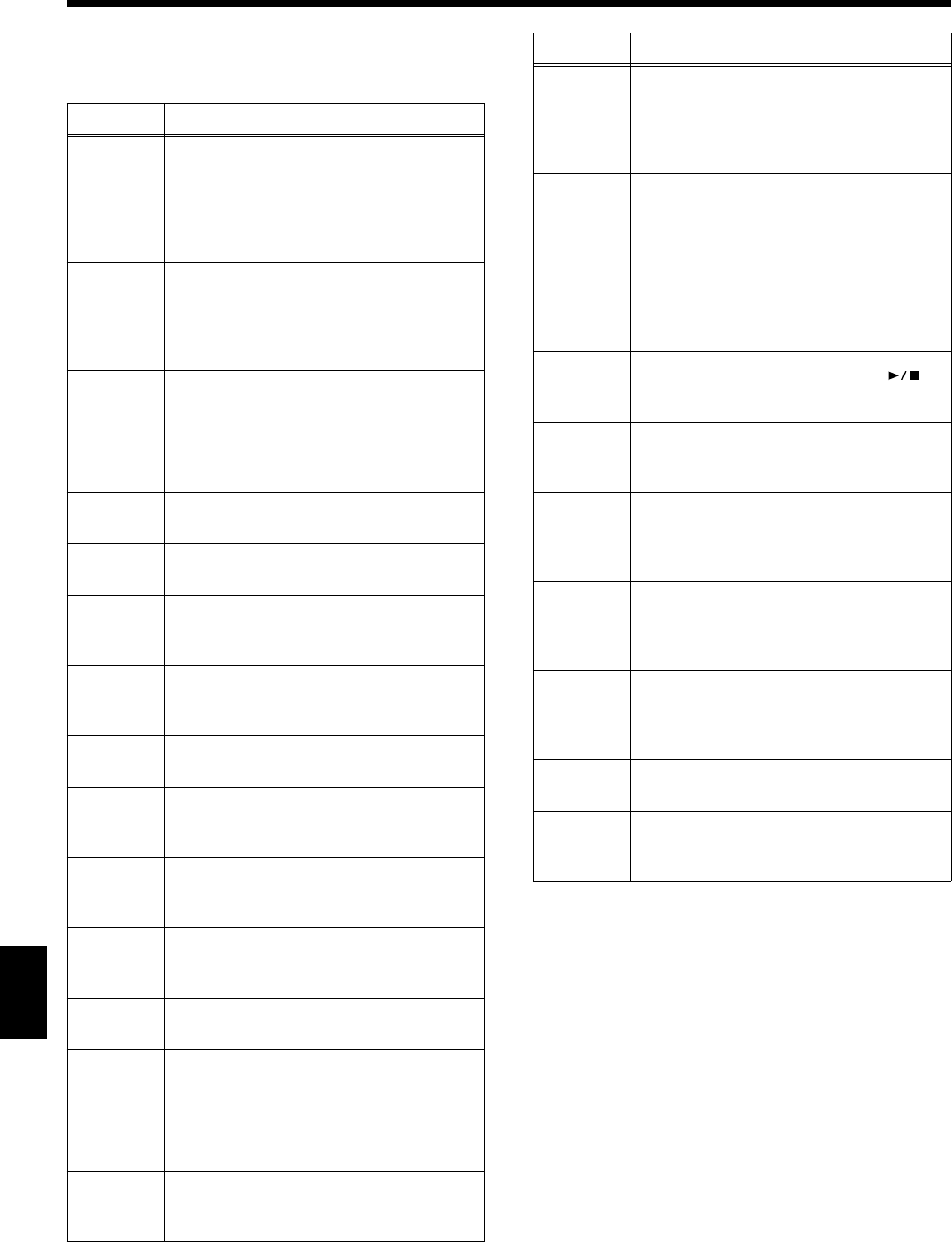
148
Chapter 8 Various Settings
Chapter 8
❍ Functions that can be assigned (Pedals,
Performance Pads)
* What is the leading bass function?
The function that sounds the lowest note of a fingered chord
as the bass tone is called “Leading Bass.” When this function
is turned on, the Bass Tone changes when chord inversions
are used. Usually the tonic of the chord you play sounds as
the bass tone.
* What is the rotary effect?
This adds a sort of spinning effect to the organ sound, similar
to the sound when a rotary speaker is used.
Changing the speed increases or decreases the speed of this
spinning effect.
Function Explanation
Leading
Bass
Toggles the Leading Bass function* on or off.
The function stays on as long as the pedal to
which this is assigned is pressed.
When assigned to a Performance Pad, this is
alternately switched on and off each time the
pad is pressed.
No Chord
Only the accompaniment’s rhythm part is
played. The next time you specify a chord
with the keyboard, the No Chord function is
cancelled, and all of the accompaniment
parts are played.
Break
During the performance of Automatic
Accompaniment, the accompaniment stops
for one measure only.
Fill In To
Variation
Performs the same function as the Fill In [To
Variation] button (p. 61).
Fill In To
Original
Performs the same function as the Fill In [To
Original] button (p. 61).
Fill In
A fill-in is inserted, but the accompaniment
pattern after that doesn’t change.
Half Fill In
Variation
This plays a fill-in half a measure long, then
switches to the Variation accompaniment
pattern.
Half Fill In
Original
This plays a fill-in half a measure long, then
switches to the Original accompaniment
pattern.
Original/
Variation
This changes the accompaniment pattern
without inserting a fill-in.
Arranger
Reset
When this function is used during Automat-
ic Accompaniment, the accompaniment re-
turns to the beginning of the Division (p. 50).
Intro 1/
Ending 1
Performs the same function as the [Intro/
Ending] button (p. 58). Intro 1 and Ending 1
are played.
Intro 2/
Ending 2
Performs the same function as the [Intro/
Ending] button (p. 58). Intro 2 and Ending 2
are played.
Arranger
Start/Stop
Performs the same function as the [Start/
Stop] button (p. 58).
Orches-
trator Up
This changes the accompaniment to a more
elavorate arrangement (p. 62).
Orches-
trator
Down
Changes the accompaniment to a simpler ar-
rangement (p. 62).
Melody
Intelli-
gence
Turns the Melody Intelligence function on
and off (p. 64).
Fade In/
Out
This starts Automatic Accompaniment with
a fade-in (where the volume gets progres-
sively louder), ends it with a fade-out
(where the volume gets progressively soft-
er), then stops.
Rotary
Slow/Fast
This switches the speed of the rotary effect*
when you perform with an organ Tone.
Glide
While the pedal or Performance Pad is held
down, the pitch of the sound drops tempo-
rarily, returning to the original pitch when
the pedal or Pad is released. This can be ef-
fective for simulating the performance of in-
struments like a Hawaiian guitar.
Compos-
er Start/
Stop
Performs the same function as the [
(Play/Stop)] button (p. 69).
Page
Fwd 1
Press the pedal or the Pad turns the score ap-
pearing on the KR display to the next page
while the performance of a song is stopped.
Page
Bwd 1
Press the pedal or the Pad turns the score ap-
pearing on the KR display to the preceding
page while the performance of a song is
stopped.
Page
Fwd 2
(KR-7)
Press the pedal or the Pad turns the score ap-
pearing on the external display to the next
page while the performance of a song is
stopped.
Page
Bwd 2
(KR-7)
Press the pedal or the Pad turns the score ap-
pearing on the external display to the pre-
ceding page while the performance of a song
is stopped.
Punch In/
Out
During Punch-in Recording, this starts and
stops recording (p. 123).
Tap
Tempo
You can set the tempo according to the inter-
val at which the pedal or pad is pressed
(p. 84).
Function Explanation


















